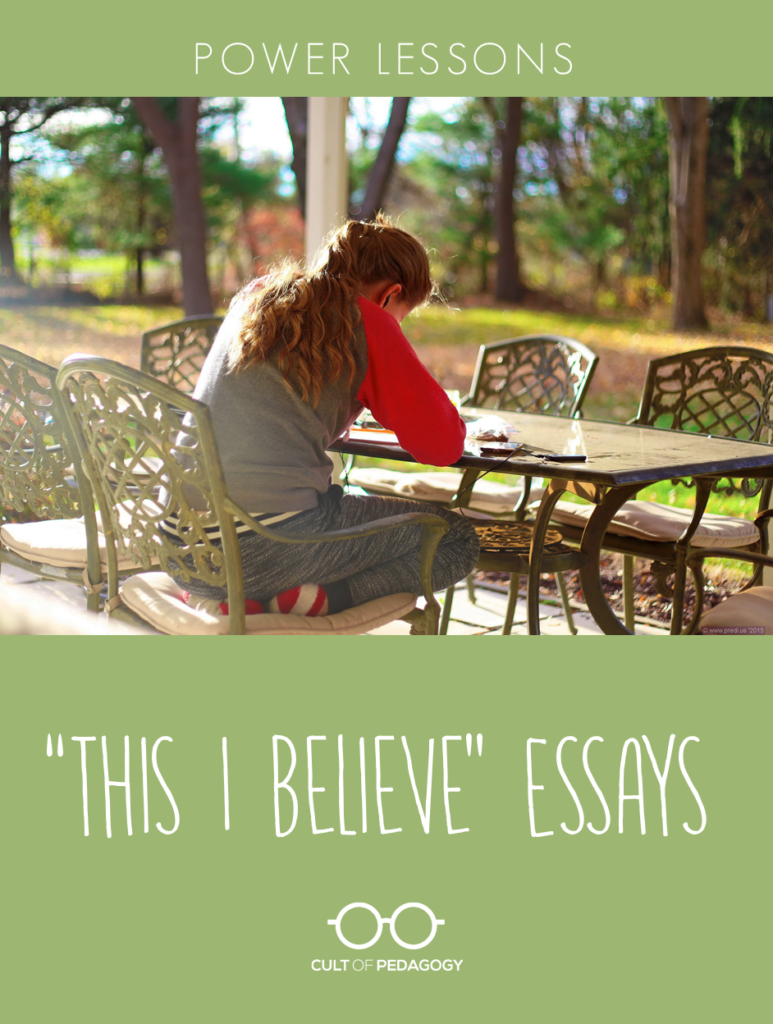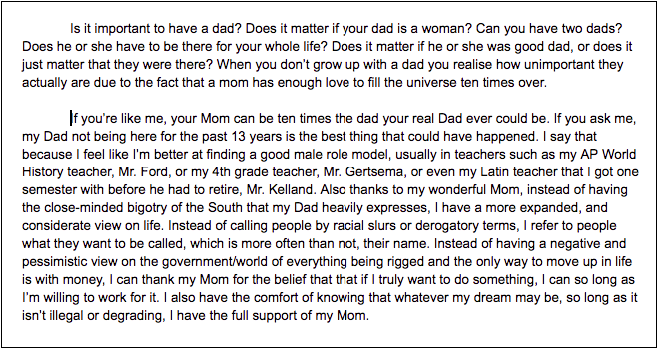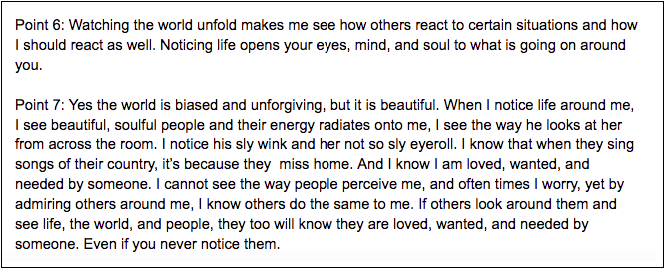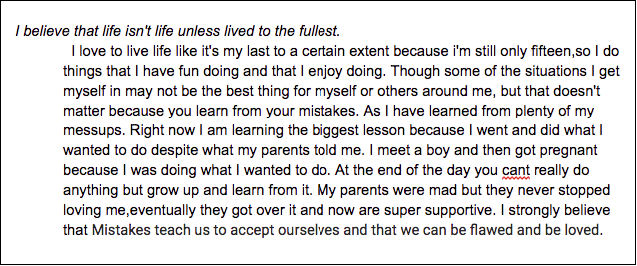Power Lesson: “This I Believe” Essays

“Doing homework” by Predi is licensed under CC BY-ND 2.0
In this power lesson shared by high school English teacher Cynthia Ruiz, students write their own personal statements of belief. The essay pushes students to write about something that matters to them and helps them get to know each other on a deeper level.
I used to assign a “Letter to the Teacher” at the beginning of every year to get a snapshot of how a student writes while simultaneously learning background information. Being completely honest, this assignment is also an easy way to get the first few back-to-school days started when a 90-minute class period feels like 900 minutes, because everyone is typically on their best behavior and not talking much. Although I enjoy reading the letters, the assignment doesn’t lend itself to revising and is written only for a specific, one-person audience.
I know building relationships with students is important and a way to get to know them is through their writing, so I did some research to see what other teachers were trying. I came across the “This I Believe” site and immediately liked the concept better than an introduction letter for a teacher.
Assignment Guidelines
The first time I assigned a “This I Believe” essay was in the fall of 2014, during the second week of school. I planned it as a year-long endeavor, something we could work on as a distraction from other essays required to prepare for state testing. This past year, I did not assign it until late April; it would be our last major writing task. I wanted to give everyone plenty of time to write but held them to a firm deadline of having four weeks to work.
This time, I crafted my writing guidelines according to those posted on the NPR site that hosts hundreds of This I Believe essays from around the world. My rubric still has some typical writing conventions, but overall I think it focuses more on student voice than structure. I made it clear that students had a lot of choice regarding both content and format. The biggest restriction came directly from the This I Believe site: a 500-600 word limit. I know a lot of writing teachers are divided when it comes to word count, but I figured it was still better than giving a specific number of required paragraphs and sentences.
One other requirement was that students use at least three “vocabulary devices.” This may seem like a restriction, but it actually supported student voice. Over the spring semester, we spent a lot of time reviewing both rhetorical and literary devices (anaphora, hypothetical questions, simile) and I told students to focus on the devices they genuinely felt comfortable using.
Helping Students Choose a Topic
Because the rubric leaves room for a lot of choice, I encouraged students to visit the featured essays site and not only read, but listen to real examples. I wanted them to see that this wasn’t just another run-of-the-mill assignment, that what they believe is important and writing is just one way to share those beliefs. I also made it a point to tell them our end goal was to share this essay with their entire class by way of a gallery walk.
After giving students time to explore the site, I had them “rush write” in their notebooks to see what immediate ideas they captured to help start the brainstorming process. Here’s the prompt I used:
This I Believe
For 2 minutes:
List words or ideas that you think about when you think of YOUR LIFE.
(Can be feelings, symbols, names, events, etc.)
After students generated this list, I asked them to consider what they wanted to write about and share with others. I wanted them to imagine a larger audience and think outside of meeting my expectations.
For some, deciding what to write about was easy and they began drafting immediately. However, the majority of students struggled not so much with what they believe, but how to write about it. Even though they appreciated having so much choice, they still needed some direction to get started.
We continued the listing strategy by focusing on “most memorables”: most memorable events in life so far, most memorable stuffed animal, most memorable friends, family experiences, life lessons learned, and so on. I asked them to focus on why they remember what they remember, and whether or not it impacts any of their beliefs. One student remembered a saying his grandmother always told him that still provides comfort as he’s gotten older. Another focused on her family not having a big house when they first moved to America and how she’s learned to be satisfied with opportunities instead of possessions. While this strategy helped a lot of light bulbs go off, it didn’t work for everyone.
Another strategy I tried was using involved sentence stems: I know I am the way I am today because______. I know I think about things the way I do because _______. I think most people would describe me as ______. I emphasized that these phrases did not have to be included in their final products, but should help generate ideas. I talked with a few frustrated students about this strategy and they told me it made them realize they’ve never really had to think about themselves in this way, but ultimately, it gave them direction for their essays.
Drafting and Revising
Because of block scheduling, I gave students about a week and a half to complete a working draft, which required having at least two paragraphs of their essay done. I only gave a portion of two to three class periods to actually write in class; students were expected to write on their own time.
On the day drafts were due, I set aside class time for revision. I asked students to refer to the rubric and focus on voice and vocabulary strategies. Questions I told them to consider were: Does this sound like me? Do I talk like this to my friends or family? I gave students the option of reviewing their own essays or partnering up with someone to peer edit. Again, this was the end of the year, so we had already established a pretty firm community of trust in class. I don’t know if peer editing would have been as easy had I done the assignment early in the year.
Overall, draft day didn’t feel like the usual “revising and editing” days we’ve had with other essays. Students were very concerned with whether or not they were making sense, if they should add more, or if they were being too repetitive, rather than only being concerned about capitalization, spelling, and grammatical errors.
Sharing the Finished Essays
The culmination of this assignment was when the essays were shared in a gallery walk. The gallery walk is my answer to having students write for a larger audience, and it really helps this essay become about what students have to say instead of just another grade. I can’t count how many times I have returned tediously graded essays only to have a kid immediately walk over to the recycling bin and trash it! Sure he read the comments and suggestions I made, or saw the cute smiley face I left by an excellent word choice, but it didn’t mean much to him because the paper is graded and finished, and he is now done thinking about it. With a gallery walk, not only are students thinking about what they wrote, but they have the opportunity to think about what their classmates wrote as well.
I printed each essay without any names, and made sure any identifying statements were revised. However, there were quite a few students who said they were proud of what they wrote and had no problem if others knew which essay belonged to them. Because not every student turned in a final copy, I printed additional copies of some completed essays to ensure every student had something to read during our gallery walk, instead of drawing attention to the two or three students who did not finish the assignment.
I placed the essays on different tables throughout the room and allowed students to move around as needed; some chose to stand and read an essay, others opted to sit, while others sprawled out on the floor to read. I played soft music and asked that the room volume stay quiet enough to be able to hear the music at all times. I didn’t mind if students were sharing and discussing, and I really wish I recorded the various conversations and comments I overheard that day: “Wow! Did you read this one yet?” “Man. Who wrote this? I might cry. Good tears, though.” “This one is life, Ms. Ruiz.”
I provided a pad of post-its near each essay and told students to leave POSITIVE feedback for each other. I provided sentence stems to help:
Something I liked…
Something I can relate to/agree with…
Something that surprised me…
Something I want to know more about…
I really think…
I periodically checked to make sure no one was being inappropriately critical or just leaving cute hearts or check marks. I wanted students to think about what they were reading, and understand that feedback is a crucial part of the writing process
After about 40 minutes, each essay had received multiple written comments, looking similar to the picture below:

Overall, the feedback was uplifting and actually created a sense of belonging in each class. Students told me they learned so much about each other that day and were shocked by their classmates’ writing. A few said they wished they had written this essay sooner.
Sample Student Work
I was floored by some of the essays I received. Some made me laugh, some made me gasp, some made me cry. Compared to the typical papers I usually assign, this essay allowed my students to not just think about what they were writing but to care about their writing and to be intentional in the language they were using, both in word choice and rhetorical strategies, because it was about what they believe. It is some of the strongest student writing I have ever received as an English teacher.
Here are some sample paragraphs from students who gave me permission to share their work:

From a student who told me he hates school and hates writing.

From a student who by all outward appearances, comes from a traditional family.

From a student battling depression and anxiety.

From a student who missed almost a whole semester but is trying to stay in school.
Although this essay helped end the year with a strong sense of community, I think teachers could easily have students write it at the beginning of the school year or even in January at the start of a new year. I’d love to hear how other teachers have used an essay like this in their classes. ♦
Have you taught a lesson or designed a learning experience we should feature in Power Lessons? Send a full description of your lesson through our contact form and we’ll check it out!
Join my mailing list and get weekly tips, tools, and inspiration—in quick, bite-sized packages—all geared toward making your teaching more effective and fun. You’ll also get access to my members-only library of free downloadable resources, including my e-booklet, 20 Ways to Cut Your Grading Time in Half, which has helped thousands of teachers spend less time grading!